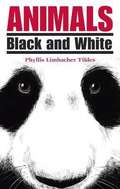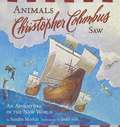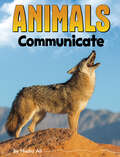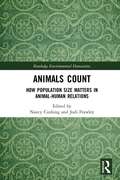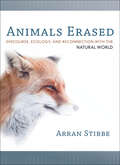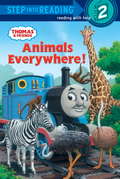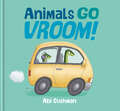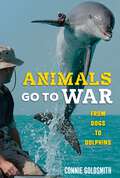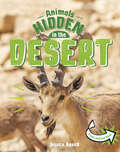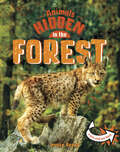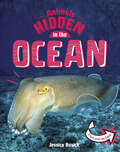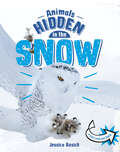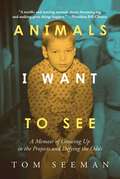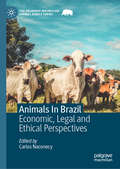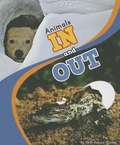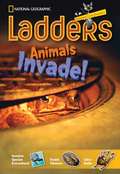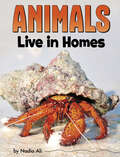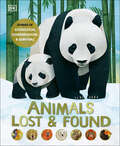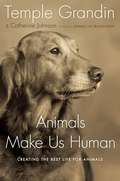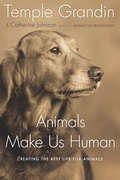- Table View
- List View
Animals Black And White
by Phyllis TildesPhyllis Limbacher Tildes deftly delivers the pieces to put together these pattern puzzles. First take a peek at each black-and-white animal and read a short clue. Can you guess who it is? Turn the page and the answer is revealed in vivid color. Animal facts are included at the end.
Animals Christopher Columbus Saw
by Sandra Markle Jamel AkibIn this series by award-winning author Sandra Markle, famous explorers take a back seat to the animals they encountered along the way. While nothing about Christopher Columbus' journey was expected, he couldn't have imagined feasting on roasted lizard! Through nimble writing and beautiful paintings, this series casts the past in a whole new light!
Animals Communicate (Animal Societies Ser.)
by Nadia AliWhales whistle, fireflies glow, and skunks spray—that’s how they communicate! Find out how mammals, reptiles, birds, and other animals send messages and signals to stay safe, make friends, and care for their young. Accessible and fun K–3 level information reveals the animal world to young readers and researchers in this Pebble Explore title from the Animal Societies series.
Animals Count: How Population Size Matters in Animal-Human Relations (Routledge Environmental Humanities)
by Nancy Cushing Jodi FrawleyWhether their populations are perceived as too large, just right, too small or non-existent, animal numbers matter to the humans with whom they share environments. Animals in the right numbers are accepted and even welcomed, but when they are seen to deviate from the human-declared set point, they become either enemies upon whom to declare war or victims to be protected. In this edited volume, leading and emerging scholars investigate for the first time the ways in which the size of an animal population impacts how they are viewed by humans and, conversely, how human perceptions of populations impact animals. This collection explores the fortunes of amphibians, mammals, insects and fish whose numbers have created concern in settler Australia and examines shifts in these populations between excess, abundance, equilibrium, scarcity and extinction. The book points to the importance of caution in future campaigns to manipulate animal populations, and demonstrates how approaches from the humanities can be deployed to bring fresh perspectives to understandings of how to live alongside other animals.
Animals Erased: Discourse, Ecology, and Reconnection with the Natural World
by Arran Stibbe“Amazingly clear and incisive readings of a wide range of discourses related to animals and ecology” from the author of Ecolinguistics (Karla Armbruster, coeditor of Beyond Nature Writing).Animals are disappearing, vanishing, and dying out—not just in the physical sense of becoming extinct, but in the sense of being erased from our consciousness. Increasingly, interactions with animals happen at a remove: mediated by nature programs, books, and cartoons; framed by the enclosures of zoos and aquariums; distanced by the museum cases that display lifeless bodies. In this thought-provoking book, Arran Stibbe takes us on a journey of discovery, revealing the many ways in which language affects our relationships with animals and the natural world. Animal-product industry manuals, school textbooks, ecological reports, media coverage of environmental issues, and animal-rights polemics all commonly portray animals as inanimate objects or passive victims. In his search for an alternative to these negative forms of discourse, Stibbe turns to the traditional culture of Japan. Within Zen philosophy, haiku poetry, and even contemporary children’s animated films, animals appear as active agents, leading their own lives for their own purposes, and of value in themselves.“Those of us of cultures of the land—both working with and, yes, consuming animals—will applaud Arran Stibbe’s analysis of the loss of soul when right relationship is discarded.” —Alastair McIntosh, author of Soil and Soul
Animals Everywhere [Grade 1, Unit 4] (Elementary Core Reading Ser.)
by Donald Bear McGraw-Hill EducationNIMAC-sourced textbook
Animals Everywhere! (Thomas & Friends)
by W. Awdry Richard CourtneyThomas rolls to the rescue after some mischievous monkeys let the animals loose from a visiting circus. Boys ages 3 to 7 will love this early reader featuring their favorite Thomas & Friends engines.
Animals Go Vroom!
by Abi CushmanWith a nod to Richard Scarry, this inventive picture book surprises readers with every turn of the page!Hiss! Screech! Roar! It's a noisy day in Bumperville! But are the sounds what you think they are? That Honk! must surely be a goose. But turn the page and it's the taxi that a goose is driving! Using cleverly placed die-cuts, this inventive book hints at what is making the sound, but with each turn of the page, it's an eye-opening surprise and part of an unfolding story that is part guessing game and part giggle-inducing caper. Abi Cushman is the master of surprise and silliness in this absolutely delightful picture book.
Animals Go to War: From Dogs to Dolphins
by Connie GoldsmithIn the twenty-first century, military marine mammals detect lost equipment and underwater mines. Large rats are trained to find land mines in more than 80 countries. Military working dogs search for explosive devices and other weapons and are trained to take down enemy combatants. In earlier centuries, military fighters rode horses into battle, relied on elephants to haul supplies, and trained pigeons to carry messages. Even cats, goats, and chickens have served in wartime—as mascots! Learn about the history of animals in warfare, the functions they serve and how they are trained, as well as the psychology that makes animals such good partners in warfare.
Animals Hidden in the Desert (Animals Undercover)
by Jessica RusickSome desert creatures are masters of disguise! They use camouflage and cover to outsmart predators or sneak up on prey. Some desert animals blend in with rocks, sand, and more. Others burrow beneath the ground or hide in shrubs. Can you spot the creatures hidden in the desert?
Animals Hidden in the Forest (Animals Undercover)
by Jessica RusickSome forest creatures are masters of disguise! They use camouflage and cover to outsmart predators or sneak up on prey. Some forest animals blend in with leaves, moss, and more. Others hide beneath rocks or in logs. Can you spot the creatures hidden in the forest?
Animals Hidden in the Ocean (Animals Undercover)
by Jessica RusickSome ocean creatures are masters of disguise! They use camouflage and cover to outsmart predators or sneak up on prey. Some ocean animals blend in with sand, pebbles, and more. Others hide in coral reefs or beneath the ocean floor. Can you spot the creatures hidden in the ocean?
Animals Hidden in the Snow (Animals Undercover)
by Jessica RusickSome creatures are masters of disguise! They use camouflage and cover to outsmart predators or sneak up on prey. In cold habitats, animals blend in with the snowy surroundings. They also hide beneath the snow in dens. Can you spot the creatures hidden in the snow?
Animals Hide (Into Reading, Level B)
by Patricia Brennan<p>NIMAC-sourced textbook <p>Sometimes it's hard to see animals in nature. That's because their colors are just like where they hide!</p>
Animals I Want To See: A Memoir of Growing Up in the Projects and Defying the Odds
by Tom SeemanA lyrical coming-of-age story set in the projects of Toledo, Ohio, Animals I Want To See explores themes of identity, ambition, religion, and friendship—often across racial and social lines—as it spotlights a family of fourteen and tracks a boy&’s journey from a child janitor with big dreams to a teenage petty criminal to a student at Yale and Harvard.&“A terrific and moving memoir about dreaming big and making great things happen.&” —President Bill Clinton &“Read it and be inspired.&” —Deepak Chopra, New York Times bestselling author On Bronson Street, in the projects of Toledo, Ohio, in a crowded house occupied by a family of fourteen, Tom Seeman starts a very important list. Just as the trash-strewn field in his backyard is home to a treasure-trove of wild animals, Tom&’s list, &“Animals I Want To See One Day,&” is home to dreams of adventure in places far away from the downtrodden neighborhood where he lives. But for all its hardship and crime, Bronson Street is also something of a mythical street, populated by unforgettable people who share food, protect each other, and give surprising gifts of beauty and merriment, proving that the bonds of community and friendship (often across racial and social lines) can bridge any divide and transcend what many of us are taught to believe about each other. A luminous coming-of-age memoir that shimmers with countless marvels, Animals I Want To See tracks Tom Seeman&’s journey from a child janitor with big ambitions to a teenage petty criminal to a student at Yale and Harvard. At once a meditation on finding wonder in unlikely places, an ode to a heroic mother who makes the seemingly impossible possible, and an exploration of what it means to create our own identities, this is a heartwarming, thought-provoking, ultimately uplifting book for all readers.
Animals In Brazil: Economic, Legal and Ethical Perspectives (The Palgrave Macmillan Animal Ethics Series)
by Carlos NaconecyThis book presents a collection of essays exploring the legal, economic, socio-environmental, and ethical dimensions of human-animal interaction in Brazil. As one of the primary global producers and exporters of beef, with a level of biodiversity in its rain-forests found nowhere else under threat, the importance of Brazil for animal life is unquestionable. Shedding light on the profound transformations in the consumption and production of animal-sourced foods that have taken place over the last five decades, the authors examine the consequences of this phenomenon for the lives of animals, the health of the population, and the environment. The book also offers an analysis of the animal welfare and animal protection legislation in Brazil, before presenting a number of notable cases involving animal advocacy and activism in recent years. An important and timely collection, this book concludes with an exploration of the historical, socio-cultural and economic aspects that influence the Brazilian ethos regarding the morality of the treatment of animals.
Animals In War
by Jilly Cooper OBEPigeons carrying vital messages to and from the beleaguered city during the Siege of Paris; horses and mules struggling through miles of fetid mud to bring ammunition to the front in the Great War; dogs sniffing out mines for the British invasion force in the Second World War - countless brave animals have played their part in the long, cruel history of war. Some have won medals for gallantry - like G.I. Joe, the American pigeon who saved 100 British lives in Italy, and Rob, the black and white mongrel who made over twenty parachute jumps with the SAS. Too many others have died abandoned, in agony and alone, after serving their country with distinction. Jilly Cooper has here written a tribute to the role of animals in wartime. It is a tragic and horrifying story - yet it has its lighter moments too: a hilarious game of musical chairs played on camels during the Desert Campaign; and the budgie who remarked, when carried from a bombed-out East End tenement, 'This is my night out'. This is a vivid and unforgettable record of man's inhumanity to animals, but also an astonishing story of courage, intelligence, devotion and resilience.
Animals In and Out (Animal Antonyms Series)
by Beth ReinkeThis book introduces the child to animals in their habitat.
Animals Invade! [Above Level, SS] (National Geographic Ladders, Common Core Readers)
by National Geographic Learning StaffNIMAC-sourced textbook
Animals Live in Homes (Animal Societies Ser.)
by Nadia AliA bear sleeps in a den. A snake might coil around a branch to rest. A crab carries its home on its back! Find out where all kinds of animals live—in the water, up in the trees, or burrowed underground. Accessible and fun K–3 level information reveals the animal world to young readers and researchers in this Pebble Explore title from the Animal Societies series.
Animals Lost and Found: Stories of Extinction, Conservation and Survival
by Jason BittelA beautiful book of extinct and endangered creatures, and a hopeful look at the futureShine a spotlight on animal species throughout history and the ones alive today in Animals Lost and Found, through beautiful illustrations and interesting facts. Children will learn about animals lost to extinction, animals we thought we&’d lost but have found, and animals that are the focus of conservation efforts all over the world.This educational book for children aged 7+ is packed with intriguing information about extinction and the different possible causes of it. Children can learn about how natural and unnatural extinction relates to the world we live in today, in a clear and easy way. Animals Lost and Found features:- A very positive outlook on conservation efforts and success stories from around the world- Focus pages on extinct and endangered animals – as well as one or two, who it turns out, never were!- Beautiful illustrations by award-winning wildlife illustrator Jonathan Woodward - Incredible conservation work that has been done around the world, like the reintroduction of Red Kites to Britain, and the effect the wolves had to the ecosystem of Yellowstone National Park- A global look at success stories and what it can do for the planetAnimals Lost and Found is not just about lost species, but also teaches children the incredible work that is happening around the world to prevent any further loss of species and looks at animals saved from extinction like the Blue Iguana! Learn the incredible stories of uncovering species thought to have been gone, reintroduction of species, and what we as humans are doing and can continue to do to help.
Animals Make Us Human: Creating the Best Life for Animals
by Catherine Johnson Temple Grandin"Can a dog be happy if you have to leave him alone for most of the day? Is the lion that paces all day in the zoo miserable or just exercising? Should you train your cat? Why do gerbils dig so much? How can we keep our animals from panicking at the vet's? Drawing on almost thirty years of research, experimentation, and experience, Temple Grandin answers these and countless other questions by focusing on the emotional needs all animals share. Animals have feelings, she argues, and we need to stimulate their positive emotions - seeking and play - while ensuring that they're free from the negative ones - fear, panic, and rage - if they're going to have a truly good life. With stories and practical insights, Grandin explains how to fulfill the specific needs of dogs, cats, horses, wildlife, and farm and zoo animals, and lets us see happiness through the eyes of our animals."--BOOK JACKET.
Animals Make Us Human: Creating the Best Life for Animals
by Catherine Johnson Temple GrandinHow can we give animals the best life-- for them? What does an animal need to be happy? In her groundbreaking, best-selling book Animals in Translation, Temple Grandin drew on her own experience with autism as well as her experience as an animal scientist to deliver extraordinary insights into how animals think, act, and feel. Now she builds on those insights to show us how to give our animals the best and happiest life-- on their terms, not ours. Knowing what causes animals physical pain is usually easy, but pinpointing emotional distress is much harder. Drawing on the latest research and her own work, Grandin identifies the core emotional needs of animals and then explains how to fulfill the specific needs of dogs and cats, horses, farm animals, zoo animals, and even wildlife. Whether it's how to make the healthiest environment for the dog you must leave alone most of the day, how to keep pigs from being bored, or how to know if the lion pacing in the zoo is miserable or just exercising, Grandin teaches us to challenge our assumptions about animal contentment and honor our bond with our fellow creatures.Animals Make Us Human is the culmination of almost thirty years of research, experimentation, and experience. This is essential reading for anyone who's ever owned, cared for, or simply cared about an animal.
